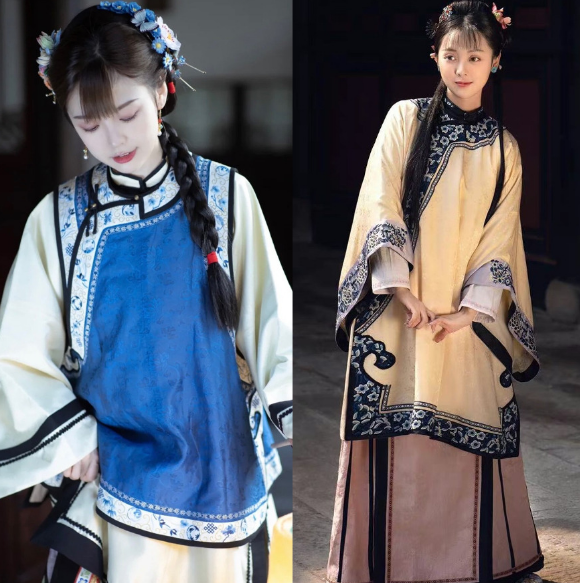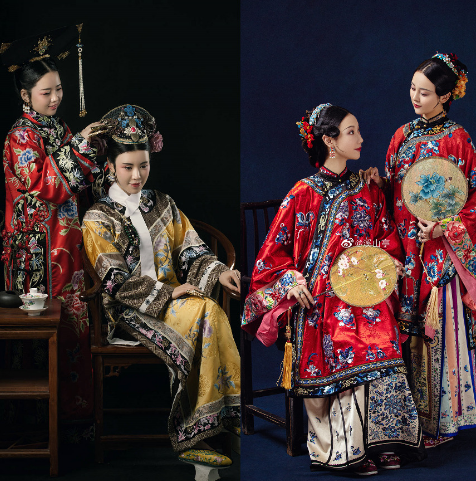Qing Dynasty Hanfu evolved due to political mandates, cultural fusion, technological progress, and socio-economic factors.
Political and Administrative Changes
Manchu Influence on Hanfu Styles
The Manchu conquest of China in 1644 dramatically transformed the Hanfu, the traditional Han Chinese attire. As the ruling class, the Manchu seamlessly integrated their distinct sartorial elements into Hanfu. This period witnessed the emergence of the Cheongsam (Qipao), evolving into an iconic symbol of Chinese femininity. Interestingly, the blend of Manchu styles into Hanfu was not just a fashion evolution but also a subtle yet powerful display of the Manchu’s political dominance over the Han Chinese. The Manchu rulers strategically used clothing to assert their cultural identity, making fashion a tool for political expression.
The Queue Edict and Its Impact on Clothing
The Queue Edict stands out as a significant regulatory move in the Qing Dynasty’s clothing history. This mandate, enforcing all Han Chinese men to adopt the Manchu hairstyle of shaving the front part of the head and growing a braid or queue, symbolized the Manchu authority. Defiance against this edict was seen as an act of rebellion, punishable by death. This hairstyle mandate profoundly influenced clothing choices, particularly headwear, making them symbols of identity and allegiance to the ruling dynasty.

Regulations and Restrictions on Dress
The Qing Dynasty also set strict guidelines on clothing based on social rank and ethnicity. These regulations specified the fabrics, colors, and designs that different classes could wear, reinforcing the social hierarchy. Sumptuary laws, dictating the clothing of various classes, played a crucial role in maintaining social order. For instance, exclusive rights to wear dragon motifs were reserved for the emperor, while lower officials and commoners adhered to simpler designs. Such dress regulations were a constant reminder of the Manchu’s political and cultural hegemony, reinforcing their dominance over the Han populace.
Through these political and administrative maneuvers, the Qing Dynasty significantly molded the evolution of Hanfu. These changes in fashion were not mere aesthetic alterations but deliberate strategies to consolidate control and blend cultures, leading to a unique fusion that defined the era’s fashion landscape. This historical episode exemplifies how fashion can transcend its functional role, becoming a potent instrument of political and cultural expression. The legacy of these changes continues to resonate in the modern interpretation of Hanfu and the broader spectrum of Chinese fashion.
Cultural Interactions and Adaptations
Integration of Manchu and Han Clothing Elements
The amalgamation of Manchu and Han clothing styles in the Qing Dynasty is a fascinating study in cultural fusion. With the Manchu’s ascent to power, their clothing styles began seamlessly blending with the traditional Hanfu. This integration gave birth to new forms of attire that symbolized a cultural merger. The most prominent example of this fusion is the evolution of the Qipao or Cheongsam. Originally a Manchu outfit, it underwent significant transformation in the hands of Han tailors, eventually becoming a tight-fitting dress that highlighted the female form. This garment not only became a fashion statement but also a representation of the cultural synthesis of the two ethnic groups.
Influence of Buddhist and Taoist Attire
Religion played a substantial role in shaping Qing Dynasty attire, especially the influences from Buddhism and Taoism. Buddhist monks and nuns, with their distinctive robes, introduced new elements into the traditional Hanfu. Taoist priests, known for their simple yet elegant attire, also impacted the mainstream fashion. The flowing robes and the use of natural colors seen in Taoist clothing found their way into everyday attire. Additionally, religious symbolism began to permeate clothing designs, with motifs like the lotus (symbolizing purity in Buddhism) and the Yin-Yang (central to Taoist philosophy) becoming popular.
Adaptations to Local Customs and Practices
The Qing Dynasty’s clothing also adapted to local customs and practices across the vast expanse of China. Regional variations in climate, materials, and local customs led to a rich diversity in Hanfu styles. In the colder northern regions, garments were heavily layered and used thicker fabrics. In contrast, the south favored lighter materials and looser fits to accommodate the warmer climate. Ethnic minorities in various regions contributed their unique styles to the Hanfu. For instance, the clothing of the Miao people in southwestern China, known for their intricate embroidery and silver jewelry, influenced Hanfu designs in those areas.
These cultural interactions and adaptations during the Qing Dynasty played a pivotal role in the evolution of Chinese clothing. The fusion of Manchu and Han styles, the influence of religious attire, and the adaptation to local customs resulted in a rich tapestry of fashion that was both diverse and unified. This era in Chinese fashion history serves as a testament to how clothing can become a canvas for cultural expression, reflecting the complexities and nuances of a society’s identity.
Technological Advancements in Textile Production
Innovations in Fabric Weaving and Dyeing
The Qing Dynasty witnessed significant innovations in fabric weaving and dyeing techniques, revolutionizing the textile industry. Skilled weavers and dyers developed new methods to create more intricate designs and vibrant colors. Brocade, a high-end fabric often used in imperial attire, became more exquisite with advanced weaving techniques. Silk weaving, in particular, saw remarkable progress, with the development of complex patterns and the use of multiple colors in a single weave. Dyeing techniques also evolved, with the introduction of new dyes that offered a broader palette of colors. These dyes were more colorfast, ensuring that the vibrant hues of garments lasted longer.
Introduction of New Materials and Techniques
The introduction of new materials and techniques significantly broadened the scope of textile production. During this period, cotton became increasingly popular, rivaling the traditional dominance of silk. This was due in part to cotton’s durability and ease of maintenance. New spinning and weaving techniques made cotton garments more accessible to the general populace. In addition to cotton, the use of wool and fur, especially in the colder northern regions, became more prevalent. Innovations in loom technology also allowed for more efficient and complex fabric production, paving the way for mass production of textiles.
The Impact of Trade on Fabric Availability
International trade greatly influenced the availability and diversity of fabrics in the Qing Dynasty. The Silk Road, an ancient network of trade routes, played a crucial role in bringing new types of fabrics and designs to China. Luxury fabrics like velvet and fine wool from Europe entered the Chinese market, enriching the variety of materials available to tailors. Trade with neighboring countries also introduced new patterns and styles, which were often incorporated into traditional Chinese garments. The influx of foreign fabrics and styles not only provided more options for clothing but also facilitated cultural exchange through fashion.
These technological advancements in textile production during the Qing Dynasty had a profound impact on the evolution of Chinese clothing. Innovations in fabric weaving and dyeing, the introduction of new materials, and the influence of trade all contributed to the diversity and richness of Chinese textiles. This era in textile history highlights the importance of technology and trade in shaping fashion trends and cultural expression. The legacy of these advancements continues to influence modern textile production and fashion design.

Socio-economic Factors Influencing Hanfu
Class Distinctions and Their Manifestation in Clothing
During the Qing Dynasty, clothing was a vivid indicator of social class, with each class having distinct sartorial markers. The elite and imperial family wore luxurious fabrics like silk and satin, adorned with intricate embroidery and exclusive patterns. Sumptuary laws played a critical role here, where only the upper echelons of society could wear certain colors, like bright yellow, which was reserved for the emperor. In stark contrast, the common populace had to adhere to simpler, more utilitarian garments made from materials like cotton and hemp. These class distinctions in clothing were not just about fashion; they were a clear representation of the hierarchical social structure, where each garment told a story of the wearer’s social standing.
The Role of Wealth and Status in Fashion Choices
Wealth and status were significant influencers in fashion choices during the Qing Dynasty. Affluent families, especially those in merchant and scholarly classes, often used clothing as a means to display their wealth and social status. Luxury items such as jade ornaments, fine furs, and elaborately embroidered robes were status symbols. The wealthy would also follow seasonal fashion trends, changing their wardrobes to reflect the latest styles. This contrasted sharply with the lower classes, whose clothing choices were primarily driven by functionality and affordability, with little room for following trends or displaying wealth.
The Influence of Urbanization on Clothing Trends
The urbanization of China during the Qing Dynasty had a significant impact on clothing trends. Cities, being the centers of trade and cultural exchange, fostered a more diverse and dynamic fashion scene. Urban residents had greater access to a variety of fabrics and styles, influenced by both domestic and foreign trends. The bustling city life also led to practical changes in clothing; for example, merchants and artisans in cities favored more comfortable and less restrictive clothing to facilitate easier movement. Urban markets became hotspots for the latest fashion, where people from different walks of life could observe and adopt new trends, leading to a more heterogeneous and vibrant urban fashion scene.
The socio-economic factors of class distinctions, wealth and status, and urbanization played crucial roles in shaping the Hanfu during the Qing Dynasty. Clothing was not just a matter of personal taste; it was deeply intertwined with one’s social identity and the economic realities of the time. These factors collectively influenced the evolution of Hanfu, making it a rich tapestry that reflected the complexities of Chinese society.







